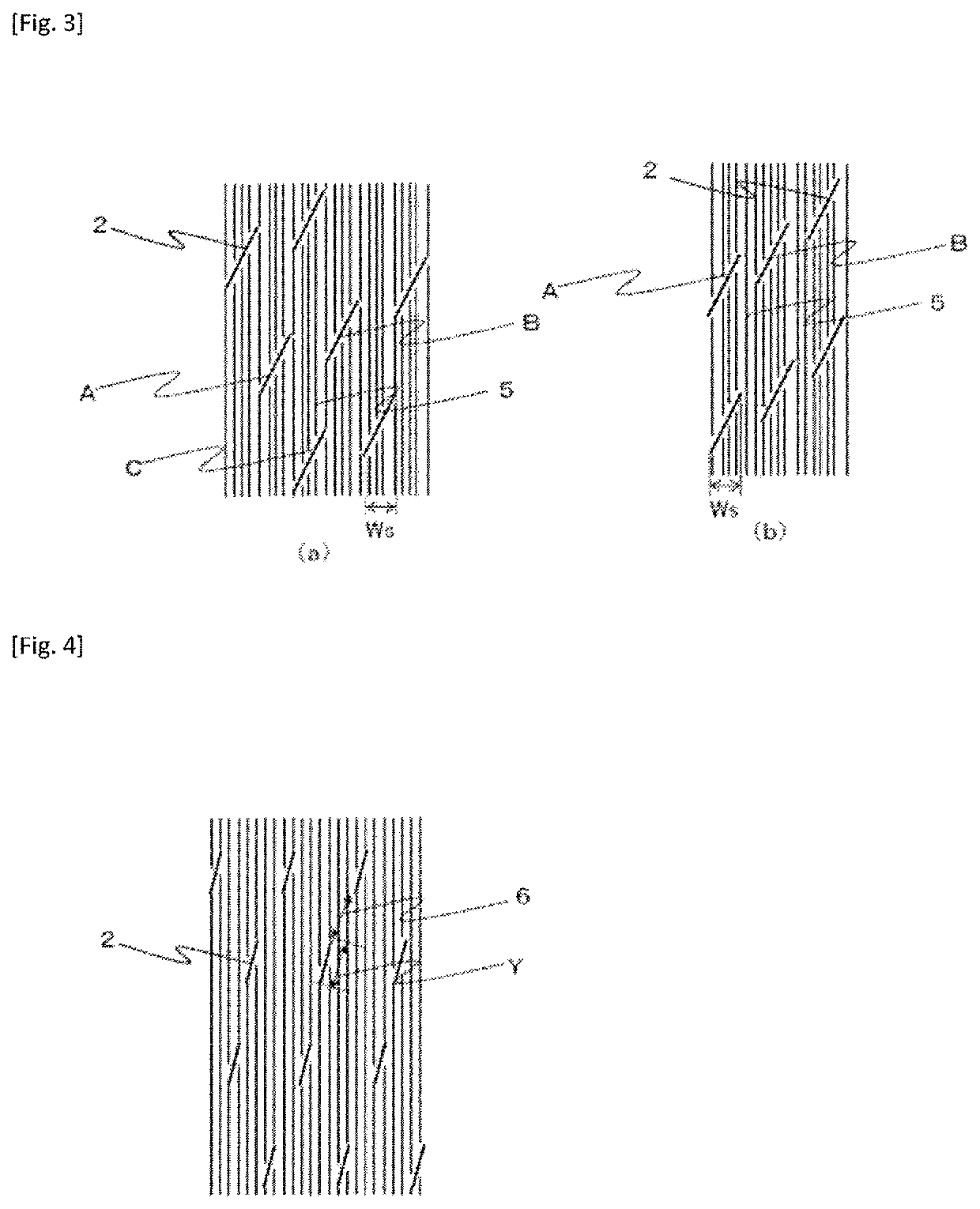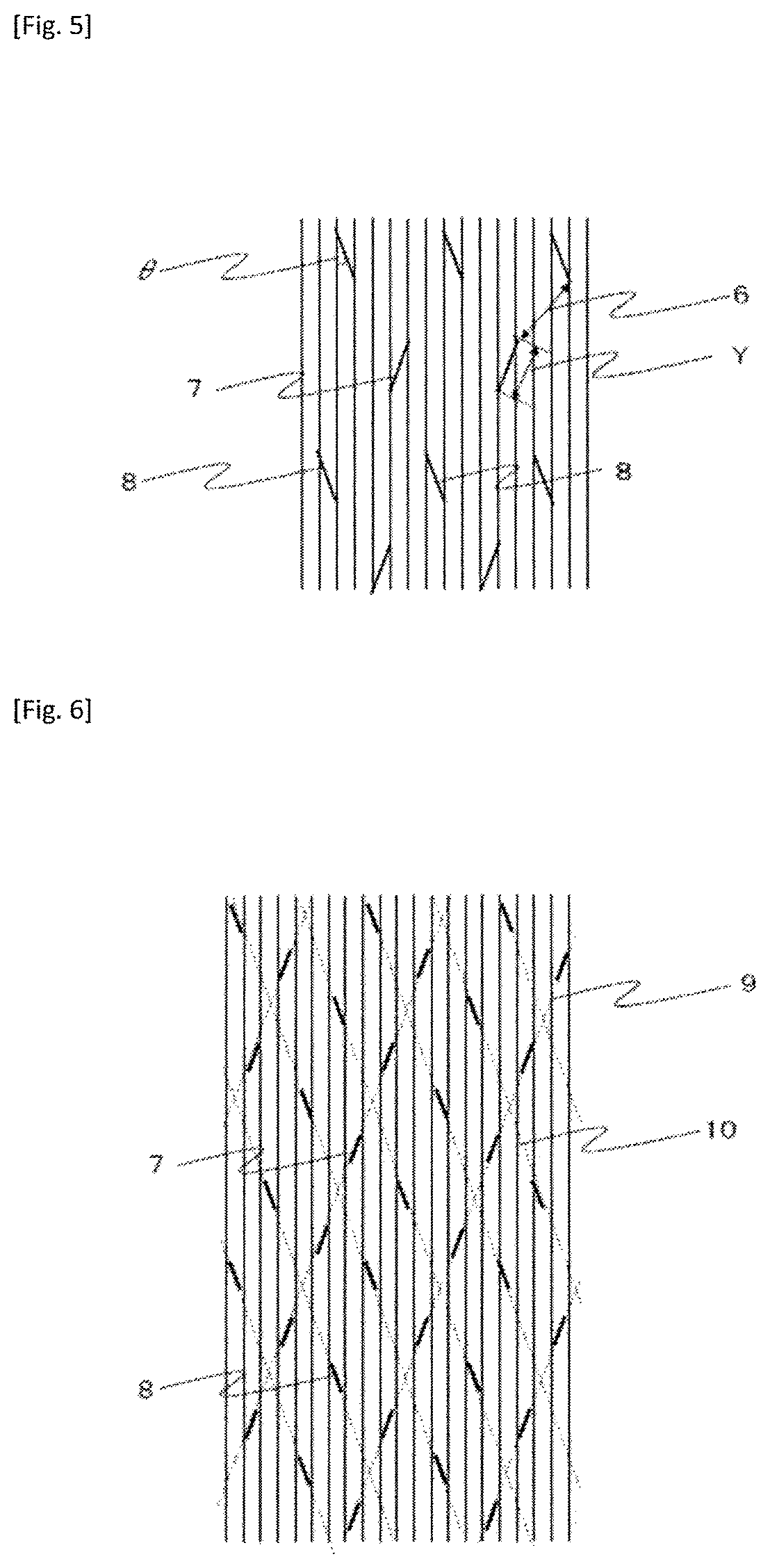[0117]A further preferable production method for an incised prepreg, a production method for an incised prepreg in which after a prepreg is passed through between the rotary blade roll and the supporting roll, the incised prepreg and a sheet substrate A are thermal pressure bonded can be cited. In cases where the adhesion between the sheet substrate A and the prepreg is weak, there are cases where the sheet substrate A peels off although the prepreg is inserted between the rotary blade roll and the supporting roll while being pressed against the supporting roll. In cases where the sheet substrate A disposed on the surface of the incised prepreg has peeled off from the incised prepreg before the incised prepreg is extracted, there is possibility that the sheet substrate A cannot support the incised prepreg and therefore the incised prepreg may wrinkle. By thermal pressure bonding the prepreg, the incised prepreg and the sheet substrate A can be adhered. With regard to a concrete temperature, there is no particular restriction. The temperature depends on the kind of the resin, the feed speed of the prepreg, etc. There is no need to give a temperature at which the viscosity of the resin extremely falls. As for the prepreg that uses a thermosetting resin, there are cases where the effect of adhesion can be obtained even at a low temperature of 50° C. or less. With regard to pressure, there is also no particular restriction. However, there is no need to apply a high pressure such that the incised prepreg is crushed. There are cases where even a low pressure of about 3 to 5 kg / cm2 achieves advantageous effects.
[0118]As a further preferable production method for an incised prepreg, a production method for an incised prepreg in which when a prepreg is passed through between the rotary blade roll and the supporting roll, a sheet substrate B has been disposed between the prepreg and the rotary blade roll and the prepreg is provided with incisions that penetrate the sheet substrate B can be cited. In cases where the resin contained in the prepreg is a thermosetting resin and has strong tackiness, provision of a sheet substrate B between the blades and the prepreg at the time of forming incisions makes it possible to inhibit the prepreg from adhering to the blades and makes it possible to inhibit adhesion of the prepreg sheet to itself when the incised prepreg sheet is wound up. The sheet substrate B may be a cover film, such as a polyethylene film or a vinyl chloride film, that protects the surface of the prepreg. Furthermore, cases where the sheet substrate B is a material, such as sponge or the like, that has stretchability have an advantageous effect of pressing the prepreg to the supporting roll side when the prepreg is passed through between the rotary blade roll and the supporting roll and also have an advantageous effect of inhibiting the incised prepreg from adhering to the rotary blade roll. Cases where the sheet substrate A is present between the prepreg and the supporting roll have an advantageous effect of inhibiting the sheet substrate A from peeling off from the prepreg by using a method in which the sheet substrate B is disposed between the prepreg and the rotary blade roll and the prepreg is provided with incisions that penetrate the sheet substrate B.
[0119]As a further preferable production method for an incised prepreg, a production method for an incised prepreg in which a prepreg is inserted and passed through between the rotary blade roll and the supporting roll while the rotary blade roll is being cooled can be cited. Cases where the rotary blade roll is cooled have an advantageous effect of cooling the incised prepreg and therefore inhibiting the incised prepreg from adhering to the rotary blade roll, particularly in cases where the prepreg contains a thermosetting resin, whose viscosity becomes high.
[0120]As a pattern of the blades provided on a preferable rotary blade roll, it is preferable that, in a circular shape formed by projecting all the blades provided on the rotary blade roll to a plane perpendicular to the axis direction of the rotary blade roll, the circular shape include no discontinuous portion or the circular shape have a discontinuous portion and, as for each discontinuous portion, the central angle formed by the two ends of the discontinuous portion and the center of the circular shape be 5° or less. Here, the discontinuous portion refers to, as illustrated in FIG. 12, a region 27 without a blade in a circular shape 26 formed when all the blades 16 on the rotary blade roll 17 are projected to a plane perpendicular to the axis direction of the rotary blade roll and the central angle formed by the two ends of the discontinuous portion and the center of the circular shape is indicated by numerals 28. In cases where such a discontinuous portion 27 is present as in FIG. 12(a), there occur instants at which no blade is pressed to the prepreg while the prepreg is being inserted between the rotary blade roll and the supporting roll. While blades are pressed to the prepreg, reaction force occurs in such a direction that the clearance between the rotary blade roll and the supporting roll expands. However, when an instant at which no blade is pressed to the prepreg occurs, the reaction force occurring on the rotary blade roll and the supporting roll is released. Thus, the presence and absence of reaction force repeatedly occur, so that the load on the rotary blade roll and the supporting roll becomes large. It is further preferable that the circular shape include no discontinuous portion or the circular shape include a discontinuous portion and, as for each discontinuous portion, the central angle formed by the two ends of the discontinuous portion and the center of the circular shape be 2° or less in any given discontinuous portion. Particularly preferably, it is preferable that, as in FIG. 12(b), the circular shape include no discontinuous portion. Furthermore, in cases where the absolute value of the angle θ formed by a blade and the circumferential direction of the rotary blade roll is smaller than 45°, the instants at which the prepreg is not pressed against any blade of the rotary blade roll can be reduced.
[0121]In cases where the rotary blade roll is provided with only blades whose θ is positive (or only blades whose θ is negative), there are cases where when a prepreg is passed through between the rotary blade roll and the supporting roll, the prepreg moves in a direction of θ and the incised prepreg gradually deviates in the axis direction of the rotary blade roll. If the incised prepreg deviates in the axis direction of the rotary blade roll, it sometimes happens that when the prepreg is passed through between the rotary blade roll and the supporting roll, the prepreg sags and, after provision of incisions, wrinkles, and it is sometimes difficult to stably produce an incised prepreg. If the blades whose θ is positive and the blades whose θ is negative are substantially equal in number, the deviation of the prepreg in its width direction at the time of providing incisions can be reduced. Incidentally, in the present invention, that the number of blades whose θ is positive and the number of blades whose θ is negative are substantially equal numbers means that, when expressed in percentage based on number, the number of blades whose θ is positive and the number of blades whose θ is negative are each greater than or equal to 45% and less than or equal to 55%. Such a highly accurate control of the incision position becomes possible by adjusting, while the prepreg is given tension, the positions of the end sides of the prepreg in the axis direction of the rotary blade roll and pressing the prepreg against the rotary blade roll provided with blades with high positional accuracy.
[0122]In the foregoing description, the shape blades provided on the rotary blade roll is a shape thereof when the rotary blade roll has been developed in a planar fashion. Furthermore, each blade may be of a straight line shape or a curved line shape. In cases where each blade has a curved line shape, θ refers to the angle formed between a line segment connecting an end portion of a blade to another end portion and the circumferential direction of the rotary blade roll.EXAMPLES
 Login to view more
Login to view more 


